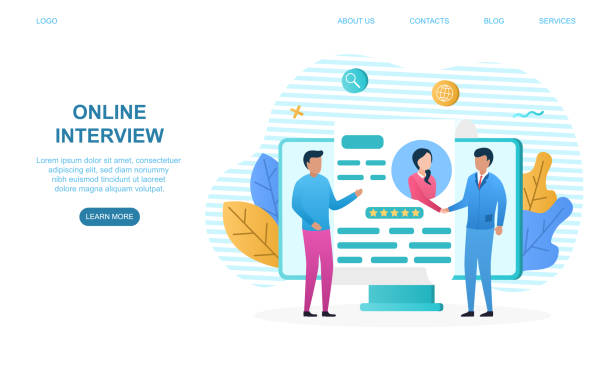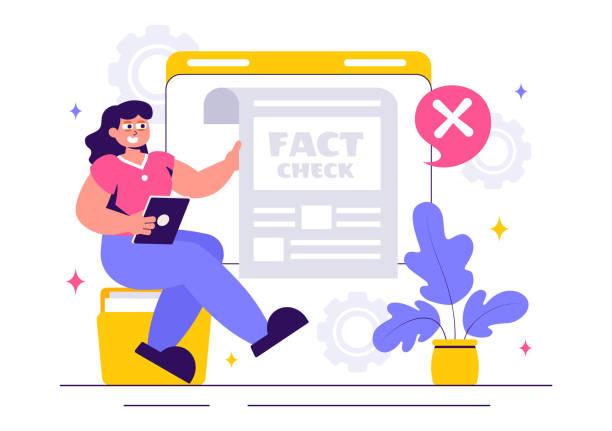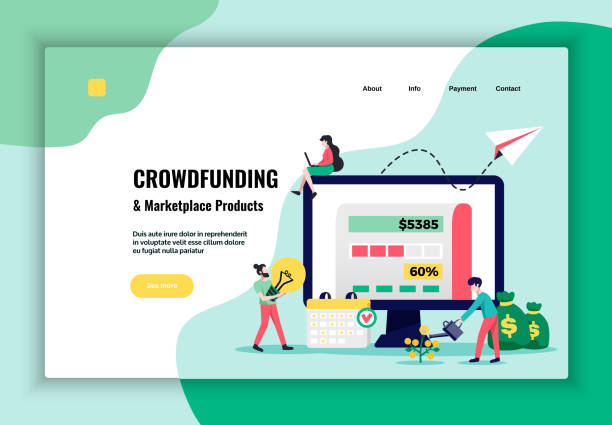Introduction to Responsive Website Design and Its Importance

In today’s digital world, where users access the internet through various devices including smartphones, tablets, laptops, and even smart TVs, #Responsive_Website_Design is no longer a luxury, but an undeniable necessity.
This approach in web design ensures that your website provides the optimal visual and user experience, regardless of screen size or device used.
The main goal of responsive website design is to adapt the content and layout of the site to different screen dimensions, so that there is no need to create separate versions for each device.
This concept is based on three fundamental principles: Fluid Grids, Flexible Images, and Media Queries.
In the past, websites were primarily designed for desktop displays, but with the explosion of mobile devices, this method no longer met user needs.
This is where the need for an innovative solution to deliver web content in any size and form was felt.
This evolution not only improved the user experience but also plays a vital role in search engine optimization (SEO), as search engines prioritize responsive websites.
Understanding these basic principles is vital for anyone looking to establish a strong and sustainable online presence, and this educational article will help you grasp the depth of this concept.
Do you dream of a thriving online store but don’t know where to start?
Rasaweb is your comprehensive e-commerce website design solution.
✅ Attractive and user-friendly design
✅ Increase sales and revenue⚡ Get free consultation
Why Did Responsive Design Become Essential? The Rise of Mobile Devices

The last decade witnessed a quiet revolution in how users access the internet.
At one time, desktop computers were the sole gateway to the web, but with the rapid emergence and proliferation of smartphones and tablets, this situation completely transformed.
This change happened so quickly that many older websites were unable to respond to this new wave of users.
Websites designed solely for large displays appeared unusable on small mobile screens, with difficult navigation and tiny, unreadable fonts.
This situation led to a very poor user experience and significantly increased the bounce rate of websites.
It was at this point that the need for a new paradigm in web design, called Responsive Website Design, became more prominent than ever. Global statistics confirm this transformation; today, more than half of web traffic originates from mobile devices.
This news trend alerted not only web developers but also business owners that if they want to remain competitive in today’s world, they must optimize their websites for mobile.
The importance of mobile-friendly design is not limited to visual aesthetics but directly impacts SEO, accessibility, and ultimately, your business’s success in the online space.
Fundamental Principles and Techniques in Responsive Website Design

Responsive website design, beyond merely resizing elements, requires a deep understanding of fundamental principles and techniques that enable adaptability. The three main pillars of this approach include fluid grids, flexible images, and media queries.
Fluid grids, instead of using fixed pixel units, utilize relative units like percentages for element widths.
This means that an element’s width, instead of being 200 pixels, might be 50% of its parent container’s width, which automatically adjusts with screen size changes.
Flexible images also ensure, using properties like `max-width: 100%`, that images never overflow their container and their size adjusts proportionally to the available space.
However, the main and most powerful technique in this field is Media Queries.
These CSS commands allow developers to apply specific styling rules based on device characteristics such as screen width, height, orientation (portrait or landscape), and even resolution.
For example, you can define that on screens smaller than 768 pixels, the navigation menu should display vertically instead of horizontally, or fonts should be smaller.
These specialized techniques enable websites to appear optimally and beautifully on any device, providing a seamless user experience.
Learning these principles is vital for every web designer.
Table 1: Comparison of Web Design Methods
| Feature | Fixed Design | Responsive Design | Separate Mobile Version |
|---|---|---|---|
| Support for various devices | Poor | Excellent (Integrated) | Medium (Requires two versions) |
| Maintenance cost | Medium | Low | High (Maintaining two codebases) |
| SEO | Poor | Excellent (Google’s recommendation) | Medium (More complexity) |
| User experience | Poor on mobile | Excellent and integrated | Separate and sometimes inconsistent |
Advantages of Responsive Website Design for Users and Businesses

Implementing responsive website design, beyond a technical aspect, brings countless benefits to end-users as well as business owners.
From a user’s perspective, the most important advantage is a seamless and optimal user experience (UX).
Users expect websites to load quickly and be accessible and readable without the need for zooming or horizontal scrolling.
A responsive site ensures that regardless of the device type, all elements (text, images, buttons) are displayed correctly and are easy to interact with.
This leads to increased user satisfaction, longer site visits, and reduced bounce rates.
From a business perspective, the advantages of adaptive web design are even broader.
Firstly, it has a positive impact on SEO.
Google has explicitly stated that it prefers responsive websites and ranks them higher in search results, especially for mobile searches.
This means more organic traffic and, consequently, increased potential for customer acquisition.
Secondly, maintaining a single codebase instead of multiple versions for desktop and mobile significantly reduces development and maintenance costs.
Thirdly, responsive websites have higher conversion rates because users can more easily access the information they need and perform desired actions (such as purchasing, signing up).
This analytical guidance shows that investing in responsive website design is a smart investment for the future of any business.
Are you frustrated with your online store’s low conversion rate?
Rasaweb, with its professional e-commerce website design, is your definitive solution!
✅ Increase your sales and revenue
✅ Unparalleled user experience for your customers
⚡ Get a free consultation now!
Common Challenges and Pitfalls in Implementing Responsive Design

Despite countless benefits, implementing responsive website design is not without its challenges, and developers may encounter numerous pitfalls.
One of the biggest challenges is Website Performance.
If not properly optimized, responsive websites can load slowly on mobile devices with poor connections.
This slowness is primarily due to the loading of large and unoptimized images or heavy JavaScript codes that are designed for desktop versions but also loaded on mobile.
It is questionable how a complete experience can be provided on all devices without harming website speed.
Another challenge is managing the complexities of CSS and JavaScript.
As the number of breakpoints and media query rules increase, CSS files can quickly become large and complex, making debugging and maintenance difficult.
Another issue is user experience (UX) design for a wide range of devices.
A design that looks excellent on desktop might be confusing or unusable on mobile, or vice versa.
Sometimes, a complete overhaul of the layout and interactions for different screen sizes is required, which demands significant expertise and experience.
These pitfalls indicate that merely knowing the technical principles is not enough, and a comprehensive and analytical approach is essential for successful implementation of responsive website design.
Effective Tools and Frameworks for Responsive Design

To facilitate the responsive website design process and address its challenges, a set of tools and frameworks have been developed to help designers and developers create highly adaptable websites.
One of the most popular and widely used frameworks is Bootstrap.
Bootstrap is a CSS, HTML, and JavaScript framework that includes powerful and ready-made UI components and a Grid System, which are designed to be responsive by default.
This framework allows developers to quickly build responsive websites with less coding.
Tailwind CSS is another framework that has gained significant popularity with its “utility-first” approach.
Instead of pre-built components, Tailwind provides a set of small, single-purpose CSS classes that can be applied directly in HTML to create custom layouts and styles.
This approach offers high flexibility for unique designs and increases development speed.
In addition to frameworks, responsive testing tools like Device Mode in Chrome DevTools allow designers to view and test their website across various screen sizes and by simulating different devices.
These educational and specialized tools provide valuable guidance to ensure the correct functioning of responsive website design across all platforms.
Future Trends and Advanced Concepts in Responsive Website Design

The world of web is constantly evolving, and responsive website design is no exception.
Future trends and advanced concepts are emerging that push the boundaries of adaptive design.
One of the most important of these concepts is Progressive Web Apps (PWA).
PWAs offer a combination of the best features of web and native applications; they are fast, reliable, and installable on the device’s home screen, without the need for app store installation.
This approach means a native-app-like user experience within a responsive web platform.
Another concept is “Mobile-First Design”, which instead of designing for desktop first and then adapting for mobile, prioritizes the mobile user experience and then enhances it for larger screens.
This method ensures that the most important content and functionality are optimized for the smallest screen.
Also, performance optimization with approaches like Lazy Loading for images and videos, and Google’s Core Web Vitals, has become crucial for providing a fast and smooth experience across all devices.
These news developments indicate the continuous evolution of responsive website design and a move towards websites that not only look good but also achieve high speed and efficiency.
Table 2: Comparison of Traditional and Advanced Web Design Features
| Feature | Traditional Web Design | Advanced Responsive Web Design |
|---|---|---|
| Main approach | Desktop-First | Mobile-First |
| Emphasis on loading speed | Less important | Critically important (Core Web Vitals) |
| Offline capability | No | Yes (with PWA) |
| Installability | No | Yes (with PWA) |
Case Study and Successful Examples of Responsive Design

To gain a deeper understanding of the potential and effectiveness of responsive website design, examining successful examples can be very insightful.
Many leading companies worldwide, including major news media and e-commerce platforms, have designed their websites responsively to provide an unparalleled experience for their users on any device.
For example, The New York Times website was a pioneer in this field, adopting a responsive approach from the outset.
This website, using fluid grids and media queries, dynamically displays its content in a readable format across all screen sizes, from smartphones to large monitors.
Another example is the Airbnb website, which, with its responsive design, allows users to easily find and book accommodations without their experience being disrupted due to device size.
From high-quality images that scale intelligently to input forms that work at any size, Airbnb is an excellent example of a functional and engaging responsive website design.
These real-world examples show how, with an analytical and specialized approach, a website can be designed to not only meet technical requirements but also succeed in delivering an outstanding user experience.
This case study provides practical guidance for the successful implementation of responsive design.
Frustrated with your e-commerce site’s low conversion rate? Rasaweb transforms your online store into a powerful tool for attracting and converting customers!
✅ Significant increase in visitor-to-buyer conversion rate
✅ Unparalleled user experience to boost customer satisfaction and loyalty⚡ Get a free consultation from Rasaweb now!
Impact of Responsive Design on Web Accessibility and Inclusivity

Responsive website design, beyond improving general user experience and search engine optimization, plays a vital role in enhancing web accessibility and inclusivity.
Web accessibility means designing websites in such a way that people with disabilities, including those with visual, auditory, motor, or cognitive impairments, can effectively use them.
A responsive website can inherently contribute to this goal, as its focus is on adapting content and layout to the diverse needs of users and devices.
For example, for users with visual impairments who use Screen Readers, a logical and hierarchical structure promoted in responsive web design ensures that content is presented to them in an organized manner.
Additionally, with the ability to resize fonts and elements without disrupting the layout, users with visual impairments can easily read the content.
This explanatory aspect of responsive design is less frequently noted but holds high importance.
By adopting an analytical approach to design that includes accessibility principles, it can be ensured that websites are usable for all individuals, regardless of their abilities or limitations.
This approach makes the web a more inclusive space for everyone.
The Future of the Web and the Continuous Role of Responsive Website Design

Looking to the future, it is clear that responsive website design will not only retain its importance but will remain at the core of web development.
As new technologies such as Augmented Reality (AR) and Virtual Reality (VR) emerge, and wearable devices and Internet of Things (IoT) become increasingly widespread, the need for websites that can instantly adapt to these diverse platforms becomes more critical.
This need for adaptive web design pushes the boundaries of responsiveness beyond merely traditional screen sizes.
In the future, we might see websites that react not only to screen size but also to the user’s environment, ambient light, distance from the device, and even their emotional state.
These developments require more specialized approaches and new concepts in design that will be built upon the solid foundations of responsive website design.
The ultimate goal is to create a completely fluid and personalized web experience that is delivered seamlessly and optimized for every scenario.
This analytical look into the future indicates that the importance of this method in web design will not diminish; rather, with technological advancements, its role in shaping the future web will become even more prominent.
Frequently Asked Questions
| Question | Answer |
|---|---|
| What is Responsive Web Design? | A web design method that ensures the website displays well on various screen sizes and devices (like mobile, tablet, desktop) and provides an appropriate user experience. |
| Why is Responsive Design important? | Improved user experience, better SEO (Google prefers responsive sites), saving time and cost (no need to build a separate site for mobile). |
| What are the main techniques in Responsive Design? | Using flexible grids and layouts (Fluid Grid), flexible images and media (Flexible Images), and using Media Queries in CSS. |
| What are Media Queries in Responsive Design? | A part of CSS3 that allows you to apply different styles based on the characteristics of the device on which the website is displayed (such as screen width, resolution, media type). |
| What are the benefits of using Responsive Design? | Access to more users (especially mobile), improved user engagement rate, reduced maintenance costs (one site for all devices), and improved Conversion Rate. |
And other services of Rasaweb Advertising Agency in the field of advertising
Smart Link Building: A professional solution for analyzing customer behavior with a focus on using real data.
Smart UI/UX: A novel service to increase user engagement through SEO-driven content strategy.
Smart Marketplace: An effective tool for customer acquisition through marketing automation.
Smart Customer Journey Map: A fast and efficient solution for increasing website traffic with a focus on marketing automation.
Smart Advertorials: A creative platform for improving customer acquisition with marketing automation.
And over a hundred other services in the field of internet advertising, advertising consultation, and organizational solutions
Internet Advertising | Advertising Strategy | Advertorials
Sources
Evolution of Responsive Design on the Web
The Future of Responsive Website Design
Principles of Responsive Website Design
What is Responsive Design?
? For your business to shine and reach its peak in the online world, Rasaweb Afarin Digital Marketing Agency is always by your side, offering comprehensive services including WordPress website design, SEO, and social media management.
📍 Tehran, Mirdamad Street, next to Bank Markazi, Kazerun Jonoubi Alley, Ramin Alley, No. 6




